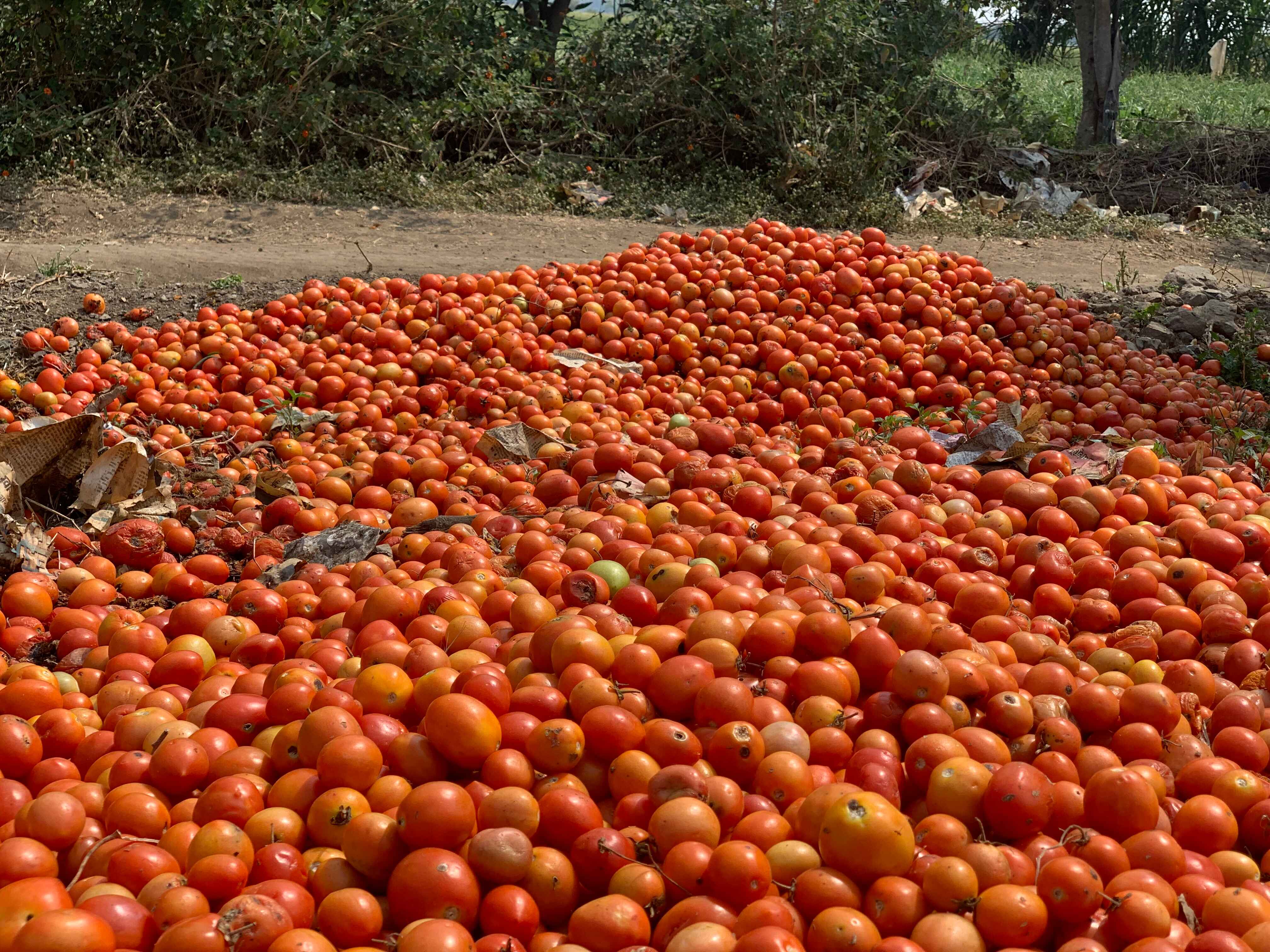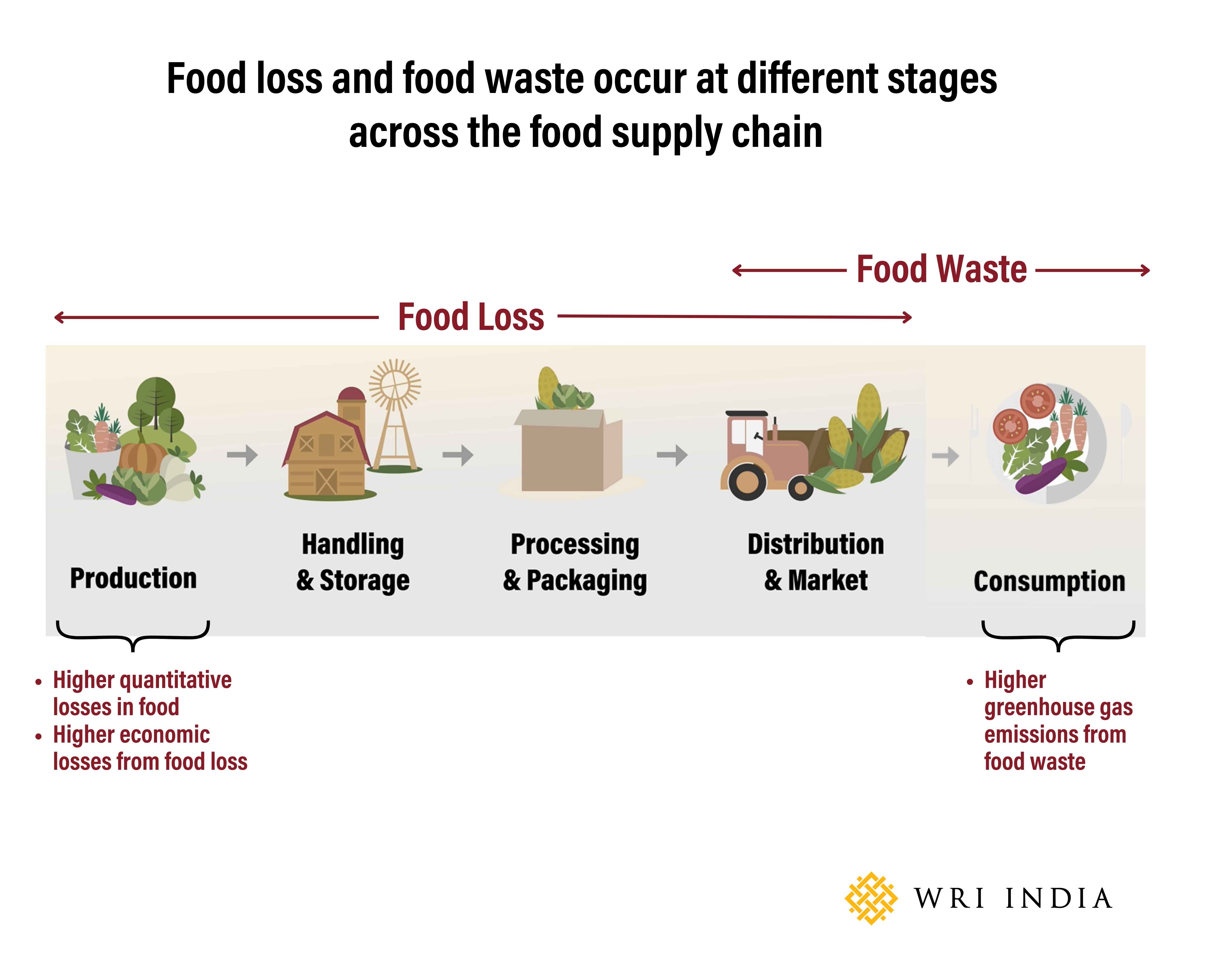Tomato Troubles: Food Loss and Food Waste from Farm to Market
by e -
In a small, predominantly tribal village of Jhabua district in Madhya Pradesh, Sushma and her husband Anil toil hard to cultivate tomatoes in the small parcel of land that they own. They are dependent on the income from growing tomatoes for their household expenses and to repay the loans they take to bear farming costs. However, it is not always profitable to grow tomatoes. Sometimes, they bear losses due to unforeseen weather conditions, pest infestation or poor market prices. Sushma and Anil point out that food losses are unavoidable in tomatoes — “If we do not sell the tomatoes in time, the tomatoes will end up selling us out”.
An inability to repay the cost of production can put farmers in severe debt. Local traders and retailers share similar experiences – perishable fruit and vegetable crops can make or break businesses. However, opportunities exist to address the challenges faced by small-scale farmers like Sushma and Anil and reduce food loss and food waste across the supply chain.
India’s Food Loss and Food Waste Challenge
India’s agriculture sector has immense potential to improve incomes, livelihoods and nutritional security while also reducing the pressure on land and resources. While India is a leading producer of food grains, fruits and vegetables worldwide, it still suffers significant food loss and food waste (FLFW). Food loss includes both quantitative and qualitative loss. As per the latest estimates by NABCONS 2022, a study commissioned by the Ministry of Food Processing Industry, Government of India, tomato incurs the second-highest postharvest losses (11.61%) in India, second only to guava (15%). However, these are only quantitative estimates and do not include qualitative losses. Tomatoes are among the major cash crops and require high investments in inputs during production. However, 82% of Indian tomato farmers have small and marginal landholdings of less than two hectares. Therefore, while small and marginal farmers play a significant role in overall production, they also risk high economic losses.
To understand the size of the problem, WRI India adopted a supply chain-based approach to track losses in tomatoes from farm to retail level, identify hotspots and solutions, and the role of clean energy in three districts – Dhar, Chhindwara, and Jhabua – of Madhya Pradesh. The paper “Tomato trail: Tracking food loss and food waste in Madhya Pradesh” identified that the highest quantitative and qualitative FLFW takes place at the farm and retail level across the food supply chain.

What is the impact of Food Loss and Food Waste?
The economic value of postharvest losses was estimated at approximately ₹1,52,790 crore (US$18.5 billion) in 2020–21, of which 37% is from fruits and vegetables. The challenge of FLFW is complex since the scale, causes, impacts and solutions vary for different geographies and crops. For instance, any losses in tomatoes impact small and marginal farmers economically and in crop planning for the next season, whereas large farmers who grow tomatoes every year recover losses in subsequent years. Additionally, any food that is lost or wasted also leads to a significant environmental footprint, including the loss of resources, such as water, energy, fertilizers and seeds, that went into its production, processing, transportation and disposal. From farm to consumption, greenhouse gas emissions are added at each stage of the supply chain.
As per our analysis, the highest quantitative tomato FLFW was found at the farm level (15%), directly impacting the farmers. Farmers in the region primarily grow tomatoes in the Kharif and late-kharif season (October – February harvesting). Farmers largely perceive any food losses in economic terms. For instance, if the cost of cultivation is recovered with a small profit, regardless of loss of produce, farmers report no quantitative tomato losses. It therefore becomes important for research to be supported by direct measurement of food losses in the field through methods such as weighing or counting. Our analysis includes direct measurement of tomato FLFW on the field using a weighing scale and recording FLFW at multiple points in the supply chain.
Quantitative FLFW for tomatoes at the retail level (12%) is also quite high. However, most unorganized retailers sell multiple commodities, reducing their risk and dependency on income from tomatoes. If there is any FLFW, the retailers try to recover the cost from other fruits and vegetables by selling those at a higher margin or selling poor quality fruits and vegetables at a lower price. Since the demand for tomatoes is year-round in India, any FLFW in the supply chain also contributes to supply shortages, leading to an increase in the cost of tomatoes for consumers.

How Can Food Loss and Food Waste be Reduced?
At the macro level, a Target-Measure-Act approach is important for guiding FLFW reduction by national and subnational governments. This encourages the government to set targets for FLFW reduction, measure and monitor progress over time, and identify specific interventions to achieve these targets. Additionally, it will also support reporting on the existing Sustainable Development Goal target 12.3.
Reducing FLFW requires solutions tailored to local conditions and target stakeholders. Furthermore, no one intervention can solve FLFW in the tomato supply chain, it requires collaboration and support from diverse supply chain stakeholders. Awareness about the scale and causes of FLFW is required, along with information about its impact on income, environment and nutrition. Next, there is a need to build capacity to leverage opportunities and implement solutions for reducing FLFW. Our analysis recommends prioritizing action at the farm and retail level by engaging small and marginal farmers and unorganized retailers. Collectivization of farmers and retailers in farmer producer groups and retailer unions is crucial for achieving economies of scale. Along with awareness, we need to improve access to technologies that have low operational costs and are environment friendly. Some of the technologies identified include evaporative cooling chambers, sun sheds and solar dryers at the farm level. If supported with the right financing, it can improve incomes and reduce greenhouse gas emissions.
During the discussion with Sushma and Anil about the extent of tomato losses on their farm, they expressed a strong interest in learning how to reduce food losses not only in tomatoes but also in onions, which they plan to grow in the upcoming season. Their intent to minimize losses is clear, but small-scale farmers like them need solutions that are affordable, sustainable and accessible at the last mile.
Read our working paper, Tomato Trail: Tracking Food Loss and Food Waste in Madhya Pradesh to know more.
Definitions :
Quantitative FLFW : When any produce that is grown for human consumption is discarded or removed from the food supply chain for purposes other than human consumption.
Qualitative FLFW : The decrease in nutritional value, appearance, smell, food safety standards and other attributes of produce that reduces its value in terms of intended use.


